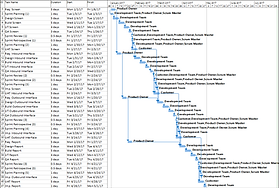Scrum - Introduction for Management


The Introduction for Management presentation, compares the success rate of projects using the traditional Waterfall methodologies, versus using Agile frameworks. It walks through a project schedule setup as a Waterfall project, and the same project setup using a Scrum framework. It walks through using iterative, incremental development, and closes with the Overview. It is 19 minutes long with the intent to show some of the benefits of Scrum, so management has enough of an overview, to consider using Scrum for some projects.
Scrum's Success Rate
This presentation shows the success rate of Agile projects is 3 times that of traditional waterfall projects. It looks at one project that failed twice as a waterfall project, but after it switch to a Scrum framework, it successfully delivered results with about half the budget and a shorter timeframe.
When Waterfall and Scrum Started
Henry Gantt introduced his Waterfall Gantt charts back in 1910, Scrum started in the early 1990’s. Gantt charts have survived the test of time, but Scrum is a development framework adapting to today’s ever increasing cycles of change with the introduction of PC’s, and the internet from the 1980’s.
Growth of Scrum
It is estimated that between 11 million and 15 million people use Scrum. While it is primarily used in the software development field, it is also used in classrooms letting students self-organize.
Scrum Iterations
The presentation compares that same project setup as a waterfall project, and using iterations in the Scrum framework. It shows a shorter timeline under Scrum, while having the same start date, deliverables, SDLC, durations, and the same number of team members. If the project is put on hold or canceled, it shows how the end user can start using what has been developed under Scrum, while a waterfall project typically doesn’t provide working deliverables until the end of the project.
Scrum's Incremental Development
Incremental Development is described and points out some of the benefits. The Scrum framework uses short iterations of incremental development, giving more opportunity for a customer to inspect and the team to adapt to what is learned. It shows how late changes in requirements are accommodated like any other requirement.
Scrum's Empirical Process Control
The presentation shows how the Scrum framework uses artifacts to keep the progress of development visible to all Scrum Team members, and stakeholders outside the team. It points out how Scrum events create the cycle of inspection and adaption, not only for increasing the value of the product being developed, but also to improve the processes used by the Scrum Team.
Scrum Overview
The presentation ends with an Overview of Scrum that goes through a cycle of the Scrum events, describing each Event, the Roles of Scrum, and the Artifacts used by Scrum Teams. The Overview notes that Scrum employees the three pillars of Empirical Process Control: Visibility, Inspection and Adaption. It shows each of these being used throughout the Scrum framework.

Here is a snapshot of the presentation's agenda:

